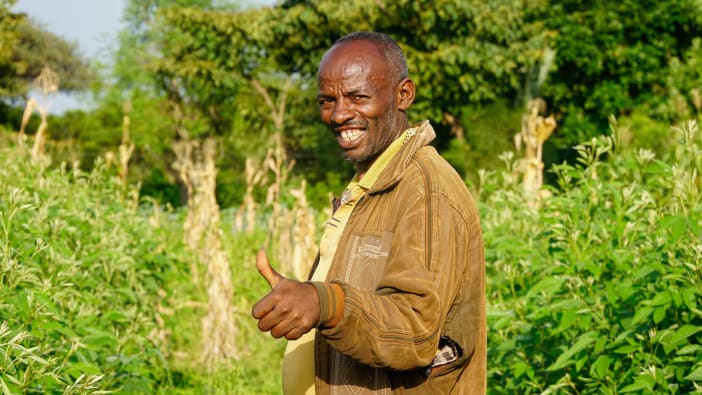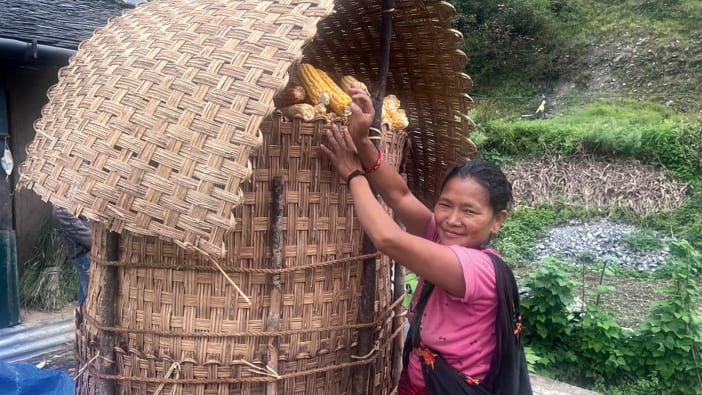To download the pdf of this article click here (PDF 256 KB)
By Mwaka Chibinga
Housing village chickens at night will protect them from rain and the cold, from predators and from theft. Also, housed birds are easier to catch to inspect for signs of illness or injury, or to vaccinate them against diseases.
Types of housing
Adult birds and growers are often provided with elevated night housing. Chicken houses built close to the ground are suitable for hens with young chicks that cannot enter an elevated house. It may be necessary to dig a drain around such a house or to raise the floor, so that it will stay dry during the rainy season. A house about 4m long, 1m wide and 1.5m high can hold 8 to 10 adult birds if they are kept enclosed all day, or about 20 for overnight housing. The house can be completely covered with wooden slats or be partly open with netting or woven bamboo.
Constructing a chicken house
A house can be built cheaply using local materials such as tree and bush branches or reeds and thatch grass. The size of the house will depend on how many birds the farmer has (or plans to have) and if they are to be kept in the house overnight or for longer periods. If too many birds are kept together they may start to peck each other, leading to injury and diseases.
Some simple rules for building a chicken house:
- Clear the grass and bush for about 3m on all sides of the house site to keep predators such as snakes and rats away from the chickens.
- Always remove the bark from timber used to construct the houses so that pests and parasites such as ticks and mites will have nowhere to hide.
- The house should protect the chickens from rain and wind but have enough ventilation to provide birds with fresh, clean air.
- The opening should be wide enough to allow the inside of the house to be cleaned easily.
- Because many infectious diseases of chickens are transmitted via their droppings, the floor of the house should have openings to allow droppings to pass through to the ground. The spaces between the slats will depend on the age and size of the chickens, ensuring they have adequate foot support and that droppings can pass through. Wire netting can also be used, with perches attached.
- If the chicken house is built on poles to protect it from predators, it should be at least 1m above the ground but not so high that the inside of it cannot be reached by the farmer.
- Putting inverted metal cones or cans around the poles of a chicken house will make it harder for rats and snakes to get into it.
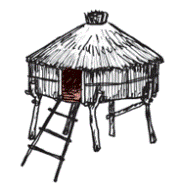
A raised chicken house made from local materials
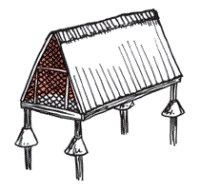
A simple mobile chicken house
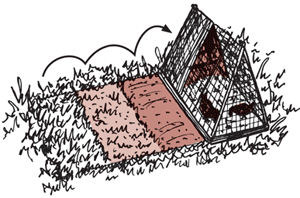
Systematic, regular movement of chicken houses and chicken runs helps prevent worm infections and allows the ground to recover from pecking and scratching. The house shown here has a floor of wire netting and is suitable for hens with young chicks.

Providing perches for roosting will minimise the contact between the birds and their droppings, and therefore help to prevent diseases. The perches can be made from bamboo or straight tree branches (remove the bark first – see ‘Constructing a chicken house’ below). They should be about 3cm in diameter. Each adult chicken requires about 20cm of perch space. If more than one perch is needed, the perches should be about 50cm apart and at the same level. If they are at different levels the birds will fight to reach the highest perch when they come in to roost in the evening, causing unnecessary stress.
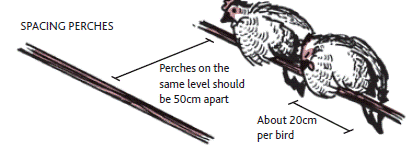
Nests
Providing clean nests in safe places means more eggs can be collected. In addition, a hen will hatch more chicks if her nest is clean, dry and safe.
Some tips on nests:
- Provide enough nests – ideally one nest per hen but not less than one nest per five hens.
- Pad the nests with clean, dry nesting material such as leaves, straw, old cloth or even sand to help to keep the eggs warm and minimise the risk of breakage or contamination.
- Eggs intended for brooding should not be completely removed from where the hen laid them, otherwise they might be abandoned. Leave at least two eggs in the nest.
- Nests should be located in safe places, protected from rain and wind, and out of reach of predators. Hens prefer nests that sit above the ground.
- Nests should be constructed in a way that protects the eggs from cooling from below or from falling out of the nest. n Nests should be cleaned regularly.
- Nests that have been used for a long time should be fumigated with smoke every six months.
- If there has been a serious outbreak of disease or a heavy infestation of external parasites such as lice, the nests should be burnt and replaced using new materials.
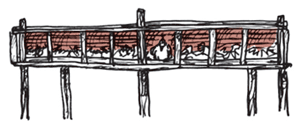
Chicken house hygiene
Cleaning the chicken house helps to prevent and control diseases, especially external parasites such as fleas and mites. The following procedures should be adopted:
- Place wood ash or lime on the floor and walls to repel external parasites and aid the removal of manure when cleaning.
- Remove droppings and litter from inside and underneath the house at least once a week and, if the house is portable, move it to a fresh area.
- Break up chicken manure so that it dries quickly – this will help to kill infectious agents and the eggs of parasitic worms within the manure. Flies will not be a problem if the manure is kept dry. Compost it for at least three weeks and then place the manure on gardens, mixing it into the soil to reduce the chance of diseases and parasites accumulating and to prevent flies from reproducing in it. The manure will fertilise the soil, leading to better plant growth.
- Fumigate the chicken house every six months with smoke (for example, by lighting a fire under elevated chicken houses or placing very small chicken houses, baskets and cages above kitchen fires) to control external parasites.
- Empty a house where sick birds have been. Clean it or even burn it and build a new one.
Mwaka Chibinga is Project Officer for the poultry project at Brethren in Christ Church, Zambia. This article has been compiled by Helen Gaw from the manual he produced, Practical village chicken production. Visit www.tearfund.org/chickens to download a free copy. If you would like a copy of this manual, please email [email protected]. Illustrations have been copied from or inspired by the Agrodok Small-scale Chicken Production (see Resources, page 13).
Resources used in Practical Village Chicken Production: Improving village chicken production, ACIAR (2009) (download free at aciar.gov.au/publication/mn139); Small-scale Chicken Production and Keeping Village Poultry (see Resources, page 13); Improving the Performance of Local Chickens, National Agricultural Extension and Research Liaison Services, Almadu Bello University, Zaria: Extension Bulletin No.92 Poultry series No 6; Commercial Production of Village Chicken (2004) by Martha Musukwa, University of Zambia.








